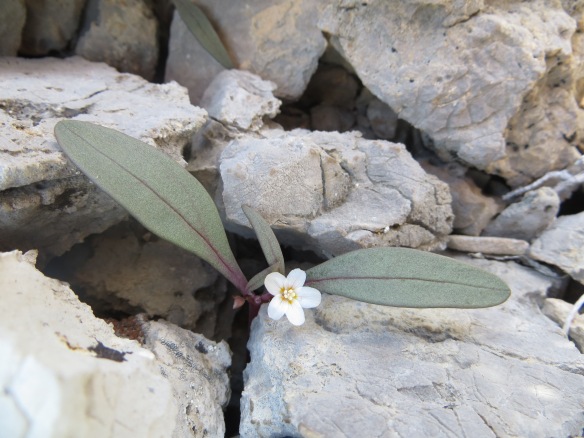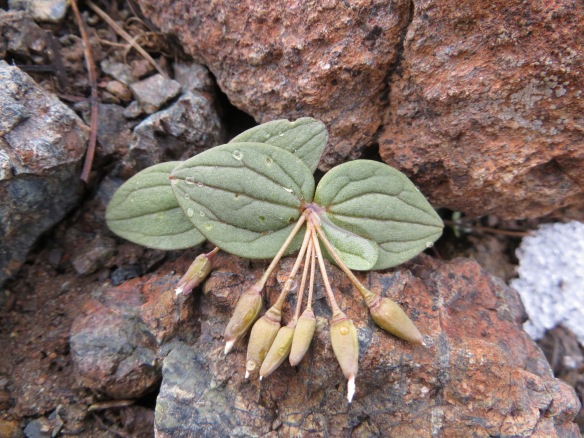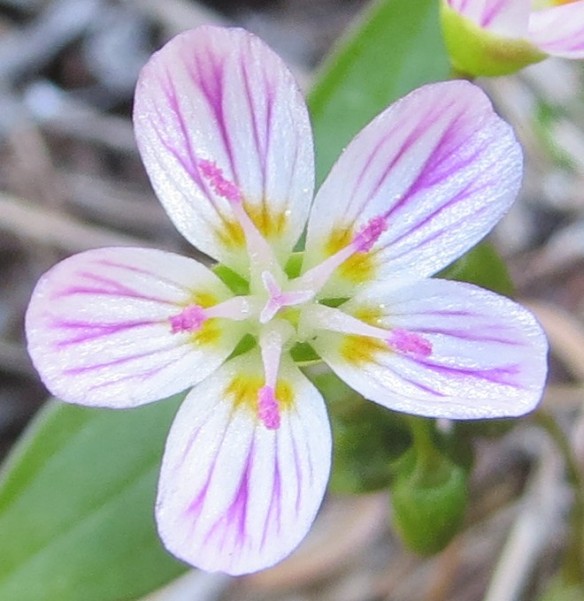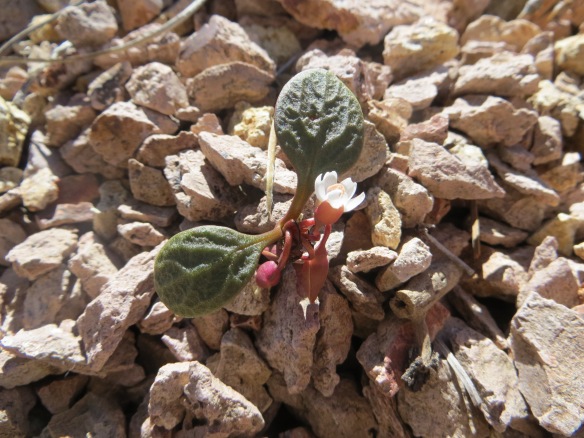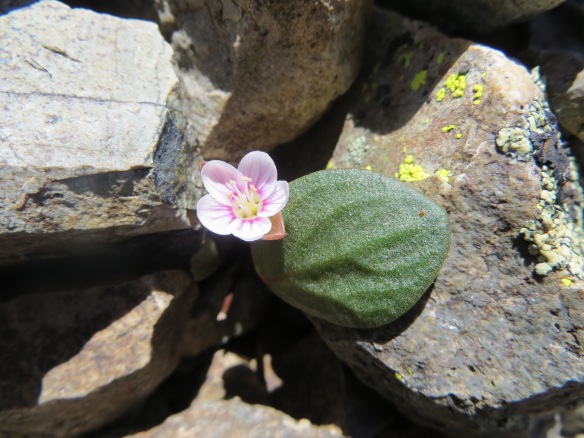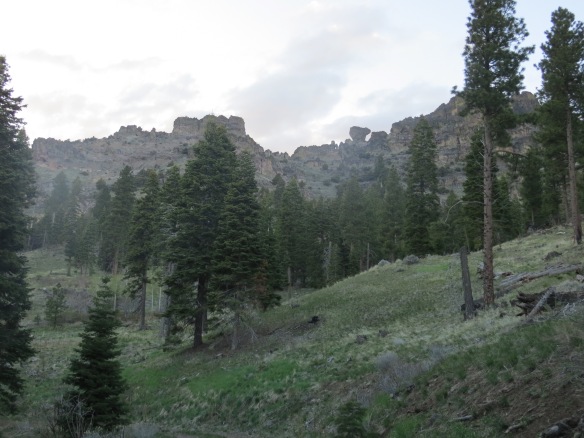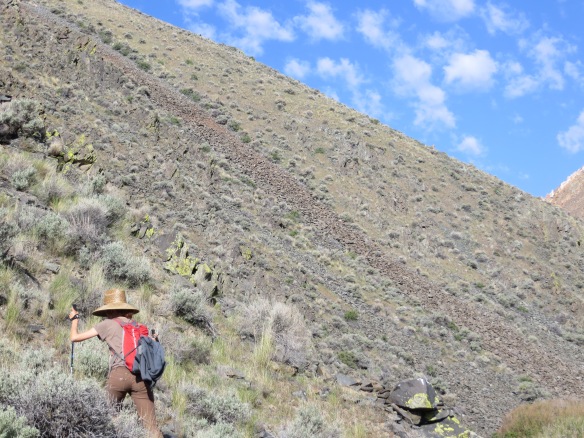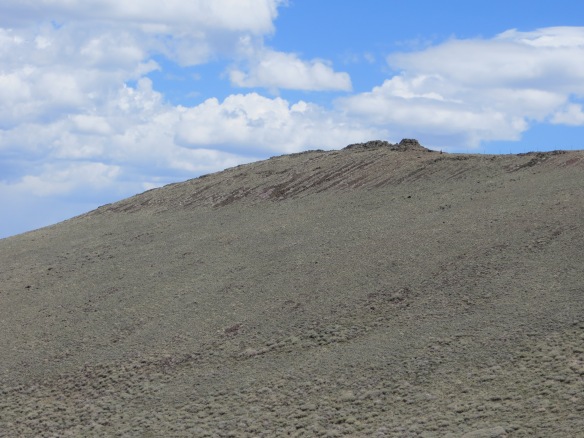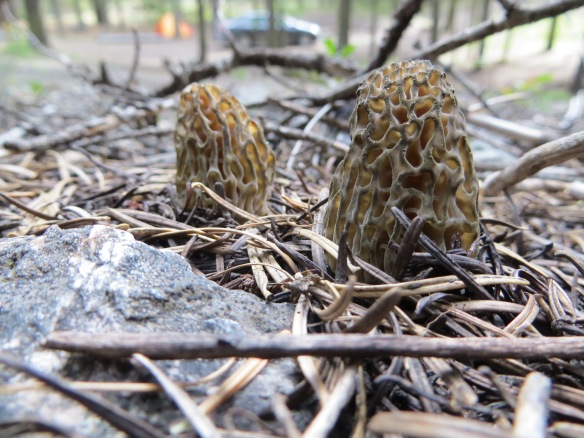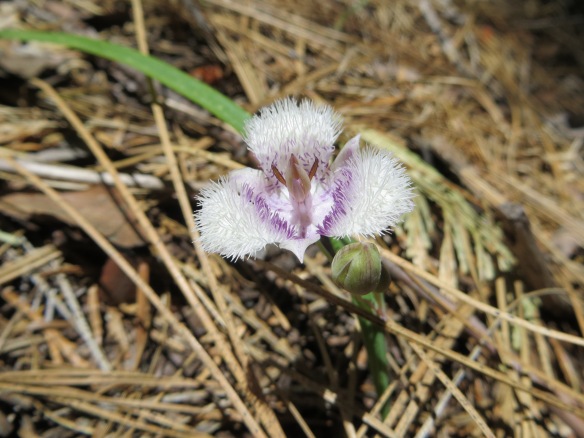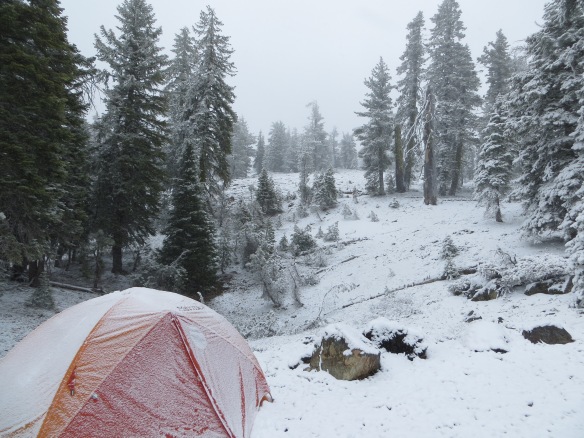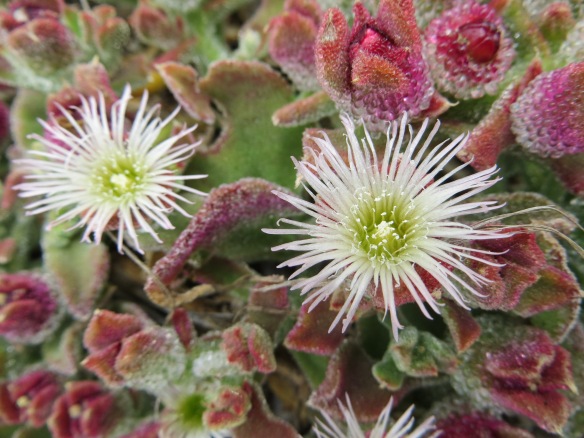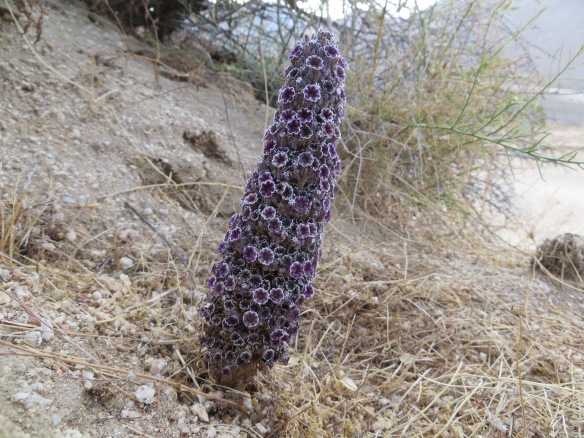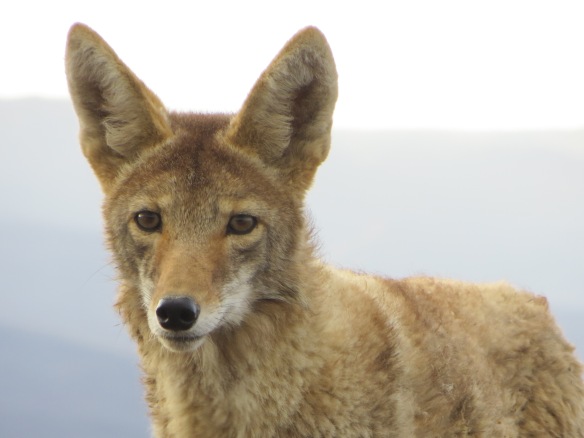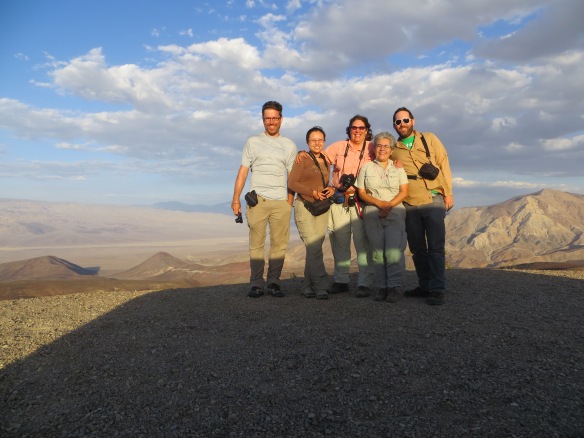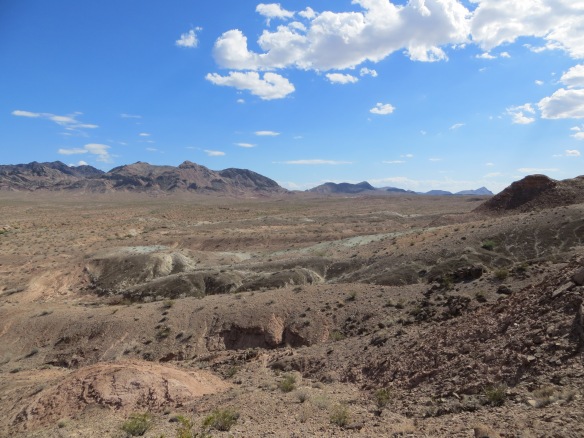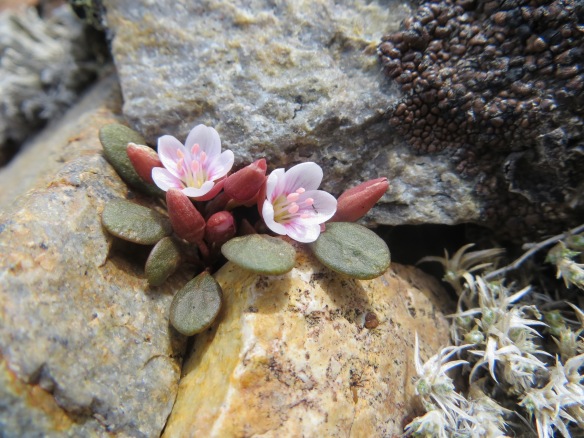
 Remember the above, beautiful plants photographed flowering a little over two weeks ago in Nevada? If not, see my previous blog post, ¡Holy frijoles!
Remember the above, beautiful plants photographed flowering a little over two weeks ago in Nevada? If not, see my previous blog post, ¡Holy frijoles!
Well, almost two weeks later Claytonia umbellata is apparently no longer flowering atop Peavine Peak outside of Reno — more snow has come (see below). These poor little guys are now packing on the pounds (and buds) getting very little exercise while they sit and wait for the warmth of a spring (beauty) day. It will come soon. In fact, I’d wager those little monsters are blooming now, as I’m writing from the comfort of my home in southern California. After all, the photographs below are from April 2nd, 2014, and these plants (desert Claytonia) are über-ephemeral. 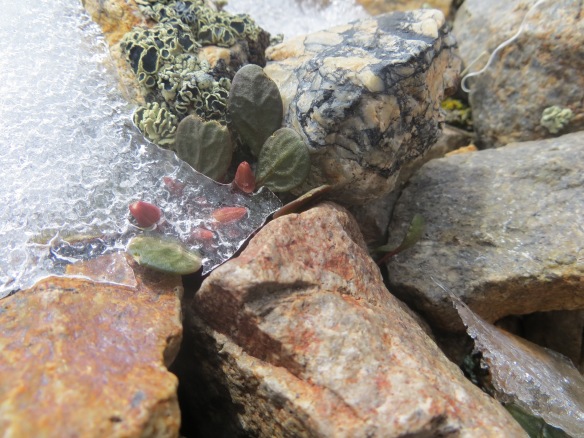 I’m so cold, I couldn’t possibly think of flowering right now…
I’m so cold, I couldn’t possibly think of flowering right now…
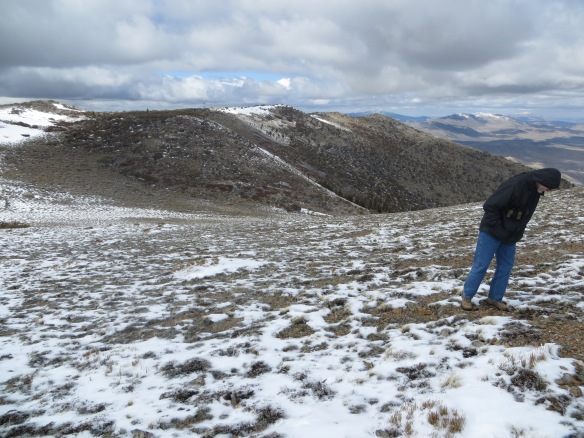
Dr. Jeff Doyle (Cornell University) trying to stay warm while searching for the elusive flowering Claytonia.
Well, this disappointment came AFTER a morning of heartbreak — searching seemingly suitable habitat without finding plants. Do I really have a good idea of what suitable habitat is? Are they even capable of dispersing here? Let’s back up for a second…
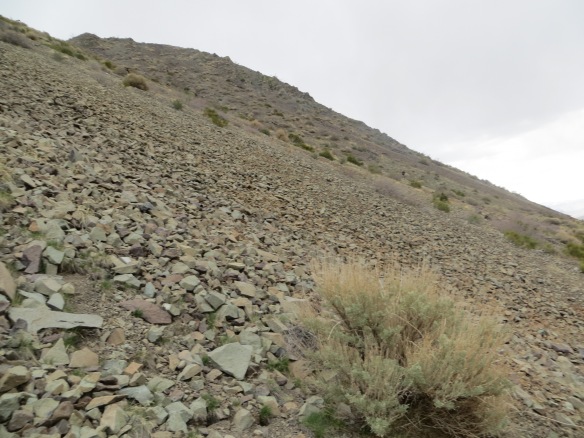 Above is a picture of a location where I collected another population of Claytonia umbellata in the Pine Nut Mountains at Minnehaha Canyon on my spring break trip nearly two weeks ago — the talus I know and love, seemingly characteristic of the Desert Southwest Claytonia. Bearing that in mind, when I see a habitat like the one above, or the one pictured below, and I am very near the type locality of Claytonia umbellata in the area of Mt. Davidson Pass (Nevada), I have to stop and take a look, right?
Above is a picture of a location where I collected another population of Claytonia umbellata in the Pine Nut Mountains at Minnehaha Canyon on my spring break trip nearly two weeks ago — the talus I know and love, seemingly characteristic of the Desert Southwest Claytonia. Bearing that in mind, when I see a habitat like the one above, or the one pictured below, and I am very near the type locality of Claytonia umbellata in the area of Mt. Davidson Pass (Nevada), I have to stop and take a look, right?  WRONG! There aren’t any Claytonia there (above), not even a C. rubra or C. parviflora ssp. viridis to cheer me up for making a bad call — Nothing! But it looks so good, and the rocks are the same as at Minnehaha Canyon… sample size of one strikes again with these guys. Ever heard the phrase, to each his own? Well, I’m beginning to think these Claytonia take that to the extreme. They are not very good at getting around (dispersal), or they have very picky palettes… or both.
WRONG! There aren’t any Claytonia there (above), not even a C. rubra or C. parviflora ssp. viridis to cheer me up for making a bad call — Nothing! But it looks so good, and the rocks are the same as at Minnehaha Canyon… sample size of one strikes again with these guys. Ever heard the phrase, to each his own? Well, I’m beginning to think these Claytonia take that to the extreme. They are not very good at getting around (dispersal), or they have very picky palettes… or both.
We have just GOT to find some flowering Claytonia, I promised Jeff and Jane! The Doyles joined me for this trip (and to give a seminar at RSABG later), flying all the way out from New York. The Doyles have A LOT of experience with eastern Claytonia, but this western stuff was pretty new for them. We sat in the car on top of Peavine Peak thinking (and not eating) — what were we going to do? That’s it! I know another place we can try, but its further north…
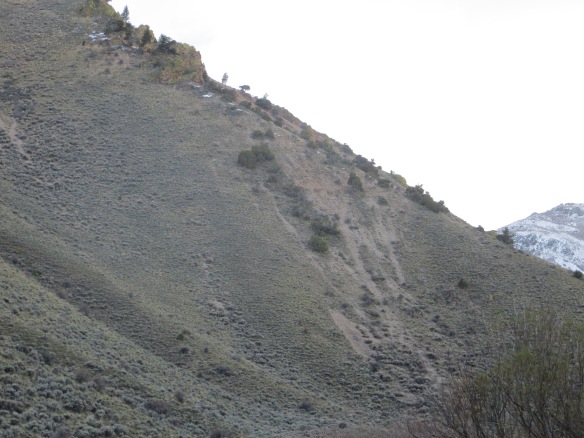 Pictured above, a talus slope of volcanic rocks in the Pah Rah Range near Pyramid Lake, Nevada. Oh no! The sun will be setting in a few hours! We can try to climb that slide and run the risk of not finding any plants, or we can try to race up the canyon to get to a known locality before dark sets in… Jeff and Jane agree, it’ll be worth giving this hillside a good look over before we continue up the canyon.
Pictured above, a talus slope of volcanic rocks in the Pah Rah Range near Pyramid Lake, Nevada. Oh no! The sun will be setting in a few hours! We can try to climb that slide and run the risk of not finding any plants, or we can try to race up the canyon to get to a known locality before dark sets in… Jeff and Jane agree, it’ll be worth giving this hillside a good look over before we continue up the canyon.
 And thank goodness we did — this area of talus was rich with numerous plants of Claytonia umbellata! We found a new locality for Claytonia umbellata, approximately one mile away from another known locality in the Pah Rah Range AND it was the large-leaved plants, like those seen in the Pine Nut Mountains at Minnehaha Canyon. Compare those to the plants from Peavine Peak (top of page), which happen to grow on different volcanic rocks!
And thank goodness we did — this area of talus was rich with numerous plants of Claytonia umbellata! We found a new locality for Claytonia umbellata, approximately one mile away from another known locality in the Pah Rah Range AND it was the large-leaved plants, like those seen in the Pine Nut Mountains at Minnehaha Canyon. Compare those to the plants from Peavine Peak (top of page), which happen to grow on different volcanic rocks!
Déjà vu — a feeling of having already experienced the present situation, independent of whether you have or have not experienced the situation or something like it… No idea what I’m talking about? See my “Claytonia rocks!”post — click here for more background information.
I still was unable, though, to fulfill my promise to Jeff and Jane Doyle — we had not yet found flowering Claytonia. There was one more chance to find flowering plants while in Nevada looking for Claytonia umbellata.This was a revisit for me, to a site in the Pine Nut Mountains where I was unable to locate a population on my previous visit. This population is near Bismark Peak, and as far as I can tell, it has not been documented by any herbarium specimen. I found out about the population by scouting CalPhotos for pictures of Claytonia — this population had been photo documented but never vouchered. I want to give a shout out to Larry Crawford, for giving me enough information to find some plants! I was not able to relocate Larry’s ‘secret patch’ of Claytonia umbellata atop Bismark Peak, but the Doyles and I were able to find a new population along the same ridgeline!
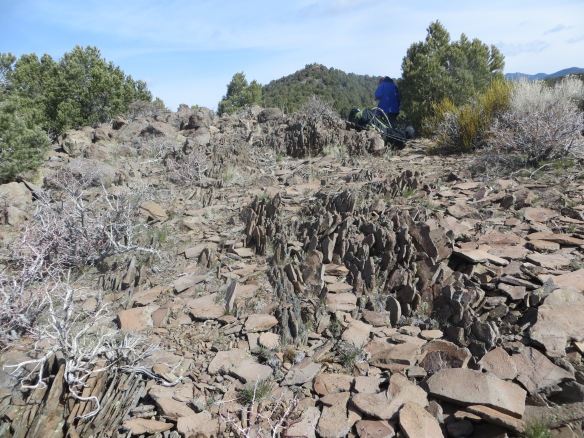 Believe it or not, and I’m sure to Larry’s delight, the plants here occur in a really unique habitat — I’m still working on the rock identification (volcanic, or sedimentary?). Crazy thing is, this Claytonia umbellata population consists of only a few plants scattered about in the cracks of the vertically oriented rocks (presumably oriented as such due to frost heaving) — they don’t seem to occur with the other rocks oriented horizontally.
Believe it or not, and I’m sure to Larry’s delight, the plants here occur in a really unique habitat — I’m still working on the rock identification (volcanic, or sedimentary?). Crazy thing is, this Claytonia umbellata population consists of only a few plants scattered about in the cracks of the vertically oriented rocks (presumably oriented as such due to frost heaving) — they don’t seem to occur with the other rocks oriented horizontally.
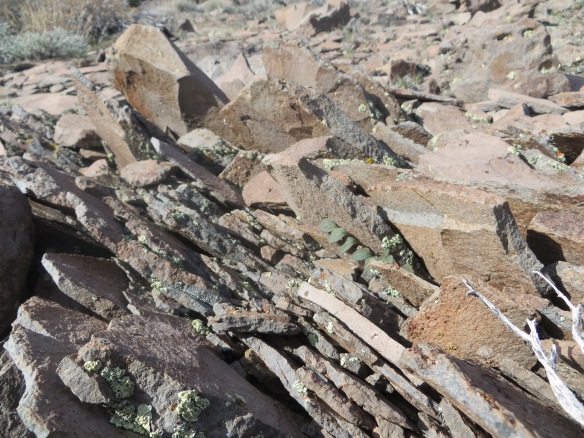 Isn’t that just bizarre! but there were STILL no flowering Claytonia to be found… I was running out of options — a revisit to the population near the Devil’s Punchbowl County Park on Saturday before Jeff and Jane’s departure seemed the most obvious choice. Rather than visiting the Devil’s Backbone (where recent snows may have set plants back from flowering), I decided we should visit a lower elevation site. Would there be flowering Claytonia hanging on at the Devil’s Punchbowl, where I observed plants flowering on February 15th, 2014? (click here to see post, “Yep, it’s Claytonia time…”)
Isn’t that just bizarre! but there were STILL no flowering Claytonia to be found… I was running out of options — a revisit to the population near the Devil’s Punchbowl County Park on Saturday before Jeff and Jane’s departure seemed the most obvious choice. Rather than visiting the Devil’s Backbone (where recent snows may have set plants back from flowering), I decided we should visit a lower elevation site. Would there be flowering Claytonia hanging on at the Devil’s Punchbowl, where I observed plants flowering on February 15th, 2014? (click here to see post, “Yep, it’s Claytonia time…”)
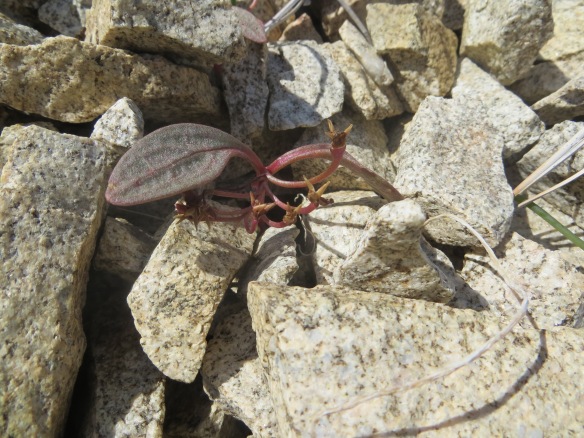 NOPE, it’s not Claytonia time here, at least not really anymore. There were some plants around with buds, but most of the C. lanceolata var. peirsonii here has dispersed its seeds and are beginning to wither back to their underground tubers. We did not find any flowering — I guess the Doyles will have to come back again next year, or meet me somewhere northward in a few more weeks!
NOPE, it’s not Claytonia time here, at least not really anymore. There were some plants around with buds, but most of the C. lanceolata var. peirsonii here has dispersed its seeds and are beginning to wither back to their underground tubers. We did not find any flowering — I guess the Doyles will have to come back again next year, or meet me somewhere northward in a few more weeks!
We did at least find some flowering Claytonia rubra there, just in the nick of time. It was time to send Jeff and Jane back to New York. Although they may not have gotten to see (much) flowering Claytonia, at least they got to see some flowering California!
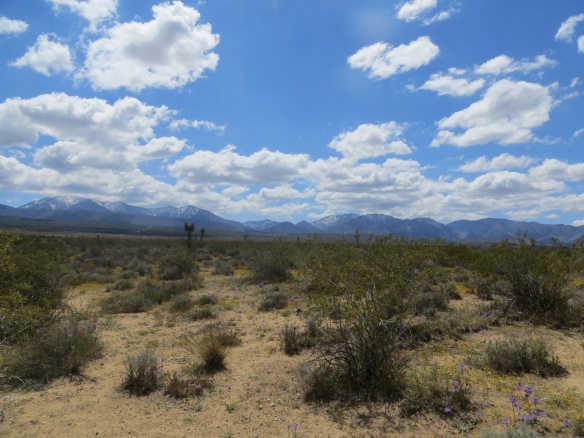
Spectacular wildflower bloom in the Mojave Desert near Piñon Hills, highway 138.
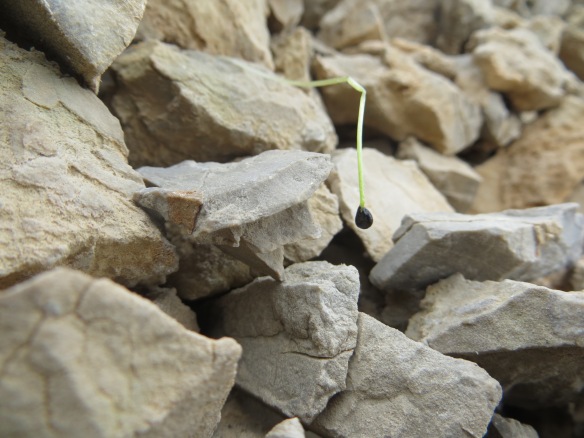 … so maybe we should start with a survey, to see what you think. How many cotyledons do you think Claytonia have? Keep in mind, they are dicots.
… so maybe we should start with a survey, to see what you think. How many cotyledons do you think Claytonia have? Keep in mind, they are dicots.
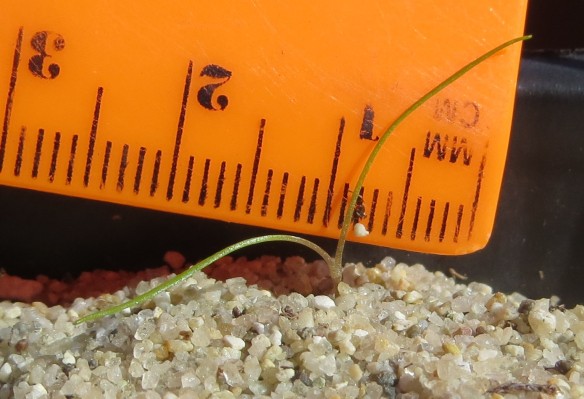 If you guessed that Claytonia have 2 cotyledons, you’re right… but you’re not the only one that is right. Technically, those of you that guessed Claytonia have only 1 cotyledon are also correct — that’s right, there is in fact a group of dicots with only 1 cotyledon (probably several, but that question exceeds the scope of this blog post). Claytonia Section Claytonia, otherwise known as the tuberous perennials, lack a second cotyledon present in other species of Claytonia (and all of their closest relatives). To me, this is just another reason why you should believe that Claytonia is the whackiest group of plants this side of the Mississippi River. 😉
If you guessed that Claytonia have 2 cotyledons, you’re right… but you’re not the only one that is right. Technically, those of you that guessed Claytonia have only 1 cotyledon are also correct — that’s right, there is in fact a group of dicots with only 1 cotyledon (probably several, but that question exceeds the scope of this blog post). Claytonia Section Claytonia, otherwise known as the tuberous perennials, lack a second cotyledon present in other species of Claytonia (and all of their closest relatives). To me, this is just another reason why you should believe that Claytonia is the whackiest group of plants this side of the Mississippi River. 😉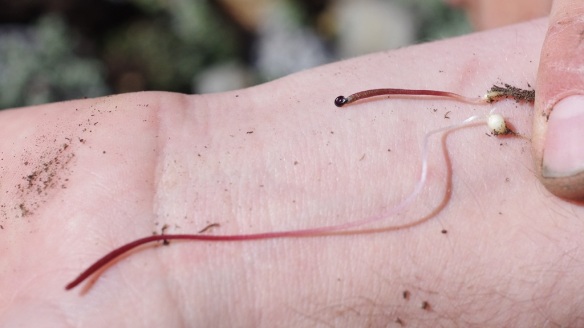 So who cares, there has been a loss of one of the cotyledons in this group of plants. One time only evolution, and now these plants simply can’t recover that lost cotyledon — I’m over it… right? WRONG! There is something fishy going on here, and it has to do with a certain caudicose perennial I have mentioned before: Claytonia megarhiza (pictured below).
So who cares, there has been a loss of one of the cotyledons in this group of plants. One time only evolution, and now these plants simply can’t recover that lost cotyledon — I’m over it… right? WRONG! There is something fishy going on here, and it has to do with a certain caudicose perennial I have mentioned before: Claytonia megarhiza (pictured below).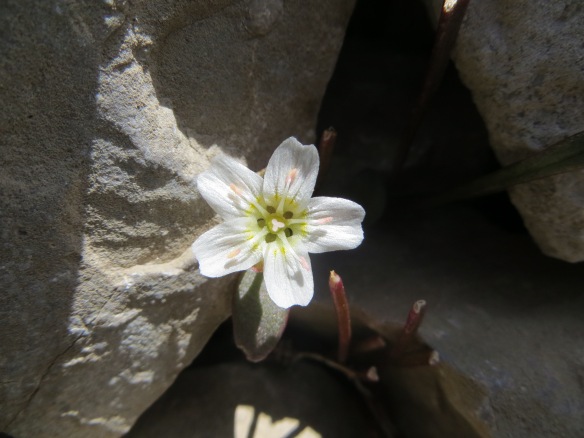
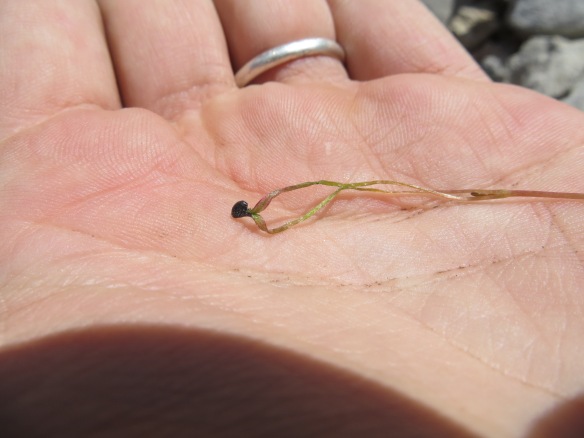 You can see from the second image (the photo immediately above) that Claytonia megarhiza clearly has two cotyledons, not one like the tuberous, perennial Claytonia species I mentioned before. Thus, you’d expect that this species is more closely related to those other Claytonia that have two cotyledons, right? Well…
You can see from the second image (the photo immediately above) that Claytonia megarhiza clearly has two cotyledons, not one like the tuberous, perennial Claytonia species I mentioned before. Thus, you’d expect that this species is more closely related to those other Claytonia that have two cotyledons, right? Well…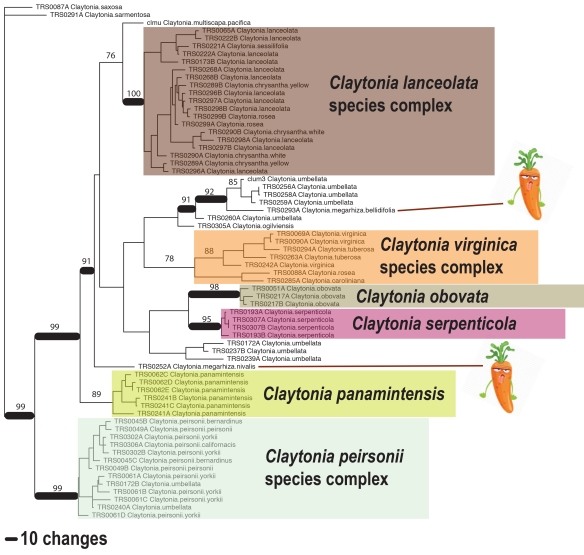 Above is a preliminary phylogenetic tree that I presented at the Botanical Society of America Meeting this year in Edmonton, Alberta, Canada. This tree has been developed from ~500 single nucleotide polymorphisms isolated from the nuclear genome of all of the samples included (using ddRADseq). You can see from the tree that the caudicose perennial C. megarhiza (indicated by [morphologically similar, but anatomically quite different] cartoon carrots ) clearly has a close association with the tuberous, perennial Claytonia, albeit the exact area in the tree where they will stabilize is still yet to be determined. Without question, Claytonia megarhiza is nested somewhere in this clade of otherwise tuberous, perennial Claytonia.
Above is a preliminary phylogenetic tree that I presented at the Botanical Society of America Meeting this year in Edmonton, Alberta, Canada. This tree has been developed from ~500 single nucleotide polymorphisms isolated from the nuclear genome of all of the samples included (using ddRADseq). You can see from the tree that the caudicose perennial C. megarhiza (indicated by [morphologically similar, but anatomically quite different] cartoon carrots ) clearly has a close association with the tuberous, perennial Claytonia, albeit the exact area in the tree where they will stabilize is still yet to be determined. Without question, Claytonia megarhiza is nested somewhere in this clade of otherwise tuberous, perennial Claytonia.
